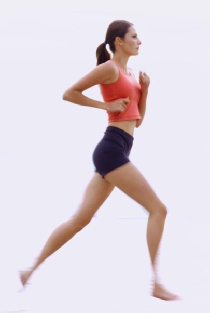












Gentle Running and Living
by Dr Patrick Salmon, PharmD, PhD
Member of the Barefoot Runners Society
Founding Member of the Tarahumara Spirit



Be gentle
to yourself
and others!
“Life is hard enough to add extra suffering to it”. We propose here a way to build a stronger, healthier and happier self through gentle running. Then, this “ascetic hedonism” can be translated into several aspects of life, to humbly contribute to a better world.

You can help your fellow humans and the world in general by sharing this site and its links.
You can join me at this email: drbarefootpat@gmail.com

Version française (en construction) à ce lien.


My blog

Run tall (The Spanish Dancer)
- Feel like trying to reach for the sky with the top of your head. It is true at any speed, the tallest, the most efficient and the fastest. If you feel that you start bending from the waist, correct immediately. Bending from the waist decreases your efficiency. Also, when you are tired, you have a tendency to do that. Not only it will worsen your fatigue, but also, your back muscles will have to work harder to pull your torso back. So not only you will need more energy for this muscles (useless to move forward) but also you will damage your back. Each time you feel you are bending from the waist, think:”I must adopt the Spanish Dancer Posture!”
Land smoothly
- Hard landing means only one thing: you are trying to punch holes into the ground! And it is unlikely that you will succeed. Instead, either the shock is absorbed by your shoes, and then you just lose energy, or it is absorbed by your joints, and not only you lose energy but one day you will need knee or hip or spine surgery. Instead, try to land smoothly, soundlessly, with your midfoot, right below your center of mass, with your knee slightly bent. This way, your foot and Achilles’ tendon, and calf muscles and thigh muscles will absorb the energy of the landing, store it and give it back to bounce and move forward. When you are tired, you tend to thump like a drop-hammer. Not only it will decrease your efficiency, but also you will destroy your joints more efficiently since all your muscles are weaker and less capable of supporting the joints.
Small strides
- Think smaller strides. Strides must get bigger as you get faster, NOT the other way around! If you try to make bigger strides by pushing with your leg, your leg will lag behind you and you will lose efficiency to pull it back. Also, you will tend to jump instead of falling forward, increasing your chance to heel-strike and hence decreasing your efficiency even more. Instead, make small strides, and progressively increase their length as you control your forward falling. When you are tired or whenever it feels hard, you tend to make longer strides. Since this decreases your efficiency, you will get even more tired and you will slow down. So, when you are tired or it feels hard, make Small Strides, it will get easier and also more efficient!
Lift the knee
- This is a neat trick to avoid your legs from pushing and lagging behind you. As soon as your foot lands on the ground, lift it by pulling your knee upward. That way, you will maximize your efficiency by 3 means: (1) your leg will not push on the ground and you will favor the “controlled falling biomechanics” and thus use gravity instead of human energy to move forward, (2) your leg will not trail behind your center of mass making it a drag to pull back at each stride, and (3) you will naturally increase your cadence and decrease your ground contact time, two parameters that are crucial for good running economy. When you are tired, you tend to let your leg trail behind because you feel that it is less effort to do like that. Simple physics and basic human biomechanics tell you it is exactly the opposite. So lift the knee!
Keep the cadence and the spring
- Humans have 2 gaits: Walking and Running. Walking is a pendular gait, is best efficient between 3 and 7 kph and has a typical cadence of 2 steps per second. Running is a spring gait, is best efficient between 7 and 21 kph and has a typical cadence of 3 steps per second. If you lower your cadence when running, your efficiency drops since you gradually lose the springiness of your legs. Correct usage of this spring effect can save as much as 15% of energy. But, this spring energy storage is efficient only if you respect a time constant that depends on the biomechanics of the fibers in your muscles and tendons. When you get tired, you tend to switch to a walk-like gait, which means you let your legs trail behind, and you decrease your cadence and your spring. That is when your efficiency drops a lot. If you are too tired, just switch to real walk, that is still more efficient than low-cadence flabby pseudo-running. Or keep your cadence and spring with smaller strides.
When you are tired
- Being tired or feeling that it is too hard, are the best opportunities to test your running efficiency and practice the items described above. Because that is when it is the hardest that you can feel the most how Gentleness and Easiness are the best tools towards Efficiency.


The Ultra Basics of Gentle and Natural Running

What do you need to remember if you forget all the information in this site?
